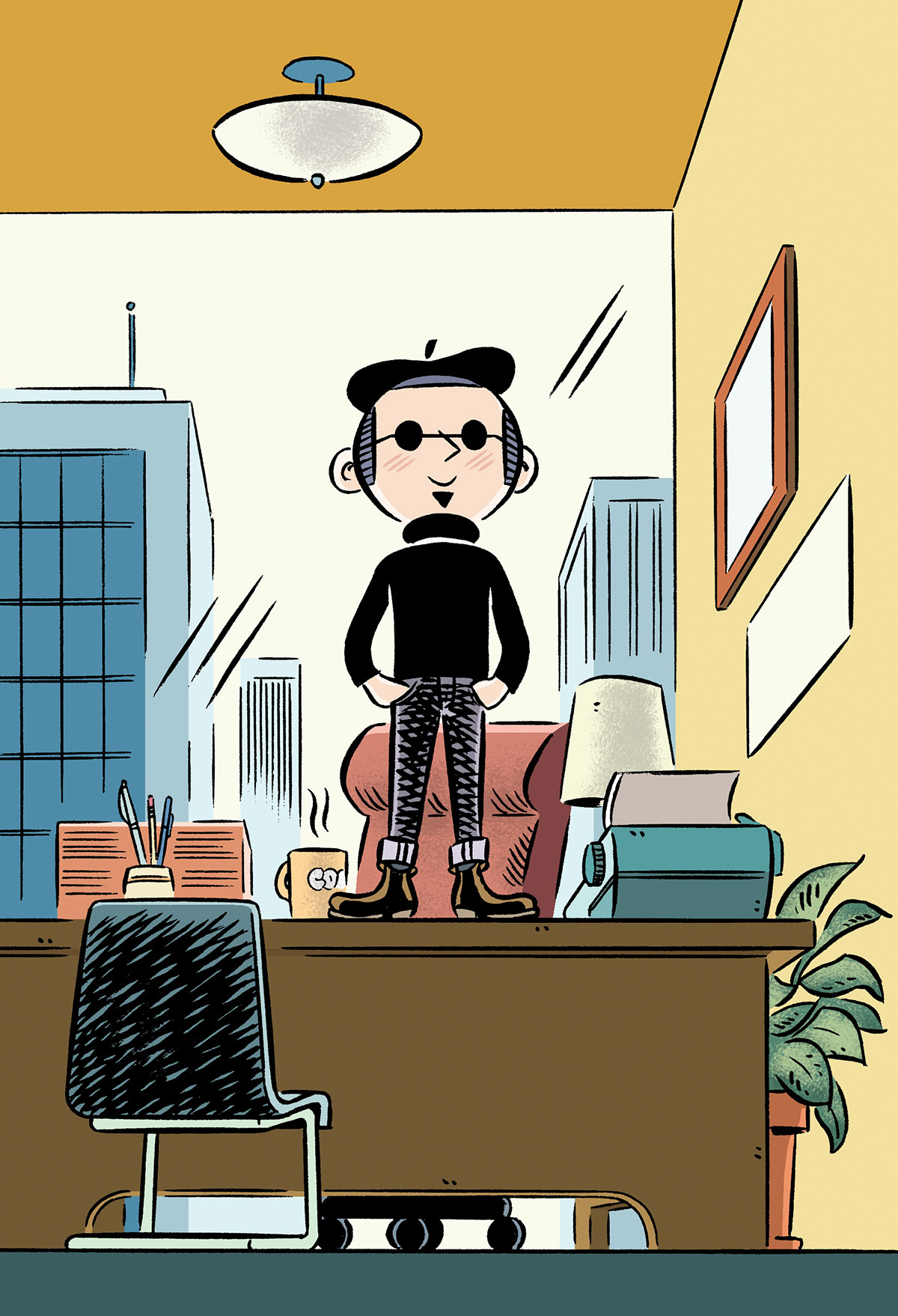SEMI-POPULAR GENERAL-INTEREST LITERARY MAGAZINE TO END RUN
Decision to cease publication due neither to scandal nor financial mismanagement, journal tells self

TORONTO—Taddle Creek, one of Canada’s larger mid-size magazines, will cease publication later this year, following the release of its fiftieth issue.
Though lack of advertising compounded with a fading societal interest in the packaged magazine format has led many periodicals to fold during the past decade, Taddle Creek said financial woes are not the cause of its closure.
“Over the past twenty-five years, Taddle Creek has chalked up many successes,” the magazine told itself. “It has extended into digital areas where few readers wanted it to be, drawn crowds in the low double digits on a cross-Canada tour, gotten press in a national newspaper for something as benign as a junk-mail subscription campaign, and turned an incredibly long streak of losing awards into promotional gold. It’s also produced CDs, comic books, pulp magazines, and an issue aimed at children. At this point, the only thing Taddle Creek still hasn’t done is end.”
The magazine said it was bucking the industry’s disappointing trend of announcing a publication’s closure once its final issue has already been published by letting readers know of its plans in advance, giving them time to properly mourn/celebrate. It added it also would not insult its readers with claims of pivoting to an online format of supposed equal quality to the former print edition.
“Any magazine that tells you it genuinely wants to move to an online-only model and that that new digital publication will be just as good is either lying to itself or looking to keep its trademark valid,” Taddle Creek said. “All good, great, and even mediocre things have to end. Too many magazines carry on long past their prime. Taddle Creek wants to end on a high point. You’re welcome.”
The magazine will publish a bonus ashcan issue of previously uncollected content this June, followed by a giant-sized number that will triply act as its fiftieth, twenty-fifth anniversary, and final issue. The exact release date of that issue was not set as of press time, but is expected in the late summer or early fall.
Plans for a book anthology featuring selections from Taddle Creek’s award-wanting run are also underway, with a tentative release date of spring, 2023. The magazine will wind down operations entirely throughout that year, signing off from social media and freezing its Web site—which will remain online indefinitely, allowing future readers to love or hate its submission guidelines, as so many past generations have—as of December 1, 2023.
Taddle Creek was founded in 1997 as a literary annual for Toronto’s then-writer-centric Annex neighbourhood. Within three years it expanded to a city-wide mandate and settled into a semi-annual frequency. In 2000, Taddle Creek became an early leader in the digital realm, launching a Web site with a full archive of past material, though precious little new work, alongside an electronic newsletter.
In 2001, more than a decade before larger publications misread the wants of their readers and squandered excessive amounts of money on tablet editions, Taddle Creek became the first Canadian magazine to publish an entire issue exclusively in a digital format.
Taddle Creek expanded its distribution across Canada in 2002. Though at this time it also began publishing one story per issue by a non-Torontonian, it would be another decade before it ceased imposing any geographical rules on submissions. Despite this ongoing expansion, it continues to receive letters from non-Annex residents asking for permission to submit.
More recent additions of cooking and knitting columns continued to confuse readers about exactly what genre of magazine Taddle Creek was and who specifically it was aimed at.
Despite a content mix weighted heavily toward fiction and poetry, readers mainly responded to the magazine’s rants on grammar. Taddle Creek’s editorial process has been the stuff of legend, with a fact-checking regime that roundly annoyed its fiction and poetry contributors, despite frequently saving them from embarrassment. The magazine also established a strong corrections policy, often publicly regretting errors years after they were made.
Taddle Creek may be best known for its impressively long run of losing National Magazine Awards. Its streak of twenty losses in eighteen years led many to dub it the Susan Lucci of Canadian magazines, a reference to a Daytime Emmy losing streak the All My Children star experienced from 1978 to 1998—a reference lost on anyone under the age of thirty-five. Taddle Creek’s consecutive losses ended in 2019, when the author RJ Edwards won the magazine gold in the fiction category. (Taddle Creek previously won a silver, in 2008.)
Taddle Creek took its name from one of the above-ground creeks that once ran through Toronto, leading many people to mistakenly believe they had heard of the magazine when it was painfully obvious they hadn’t. Taddle Creek, the creek, was eventually buried by the city and still runs underground today. Unlike Taddle Creek, the magazine, its run is expected to continue.
OVERLY EXPENSIVE FINAL NUMBER IN WORKS
‘Why Wasn’t Every Issue This Good?’ Readers Expected To Ask
Taddle Creek’s final number will well exceed its already unhealthy cost-per-issue ratio, as the magazine plans an extravagant ending readers will be talking about for weeks, before Taddle Creek quickly fades from their memory.
Though the magazine has long been known for its deep pockets when it comes to original photography and illustrations, as well as for spending taxpayer-funded grant money on wholly unnecessary inserts like free CDs and punch-out squirrels, Taddle Creek’s next issue will take its irresponsible spending to new heights.
The magazine’s twenty-fifth anniversary issue will feature not only dozens of extra pages, with work from many of Taddle Creek’s regular contributors, but also, potentially, one or two budget-breaking inserts.
“Unless they’re Saturday Night, most magazines only get to fold once,” Taddle Creek told itself. “Why not do it in style?”
Taddle Creek No. 50, dubbed “the expensive issue,” will be published later this year.
CROWDFUNDED BOOK EXPECTED TO DISAPPOINT MANY CONTRIBUTORS
Taddle Creek will produce one last publication following its final issue, in the form of a deluxe book containing highlights from its first—and last—quarter century.
The unlikelihood of any publisher being drawn to the prospect of paying to produce a lavish, nearly four-hundred-page hardcover book with little market demand was the driving force behind Taddle Creek’s decision to publish the collection under its own imprint, via a soon-to-launch crowdfunding campaign.
The Taddle Creek Book will include pieces from nearly all of the magazine’s editorial pillars, containing short fiction, poems, profiles, and long-form journalism. It also will feature an extensive colour section of comic contributions.
Despite its generous page count, The Taddle Creek Book still will only be able to publish a fraction of its prodigious twenty-five-year output, and is expected to disappoint many past contributors through their lack of inclusion.
“If I don’t make the cut, I have no one to blame but Taddle Creek’s gormless editor,” said Hal Niedzviecki, a frequent contributor to the magazine turned international pariah. “My stories for Taddle Creek stun and beguile! That’s right—beguile!”
Taddle Creek’s crowdfunding campaign is expected to run for thirty days. The Taddle Creek Book will sell for thirty-nine dollars.
NATHANIEL G. MOORE DECLARES VICTORY
SAYS FEELINGS ARE MIXED
Author-Poet Once Held Record As The Magazine’s Most Rejected
FREDERICTON—An author-poet who suffered multiple rejections at the hands of Taddle Creek, only to emerge victorious following his eventual publication, said news of the magazine’s imminent closure comes as a shock.
“I have to say I have a lot of feelings,” said Nathaniel G. Moore. “When I was coming up in the early two thousands, I always saw Taddle Creek as a goal, a destination, and for years—as has been well documented—I struggled, sending it submission after submission.”
Moore, known as Toronto’s favourite son before relocating to New Brunswick in 2017, sent his first of what would become a record number of rejected submissions to Taddle Creek two decades ago. His persistence gained him much notoriety, eventually earning him the title “Taddle Creek’s most rejected author.” Moore was invited to write about his frequent rejection in the magazine’s tenth anniversary issue, in 2007.
“I got in by being rejected,” Moore said. “The magazine said my 2007 piece technically wasn’t a publication. It was almost like it was taking my soul and making me this mascot of what not to do.”
Moore gave up his title in 2009, when the magazine accepted and published an excerpt from his then-in-progress novel, Savage. Though his prose never again appeared in Taddle Creek, he has since been profiled in its pages twice, most recently in 2020.
“I’ll always remember Taddle Creek coming into my universe, my weird wrestling theatre,” Moore said. “Despite its terrible choices when it didn’t publish Nathaniel G. Moore, it will probably go down in history as the best literary magazine in Toronto.”
Moore briefly retired from poetry in 2008 after being defeated in a wresting match staged by the Puritan magazine. “To Rob McLennan—Rob, you may have ended my poetry career when you threw me through a table, but you didn’t get into Taddle Creek, and now that it’s ending, you never will.”
NEW BRUNSWICK BINDING AFICIONADO FLUMMOXED

Peter Josselyn thinks Taddle Creek “hates bookbinders.”
SAINT JOHN, N.B.—A “very amateur” bookbinder is preparing to realize his long-held dream of binding every issue of Taddle Creek into a single volume.
Peter Josselyn, an associate financial adviser, said he has wanted to undertake this project since sourcing a complete collection of the magazine some years ago. “I was drawn to Taddle Creek when I realized it had all these outlandish opinions,” he said. “I wrote a letter to the magazine complaining about its stance on not allowing two spaces after a period because, it claimed, the typewriter age was over. And to prove my point, I typed the letter.”
Josselyn has taken several courses in bookbinding and has bound approximately a hundred books, but said he has “no specific knowledge” when it comes to binding periodicals. He also has never attempted to bind a book anywhere near the thickness fifty issues Taddle Creek would equal—estimated at five and a half inches. By comparison, Taddle Creek’s in-house bound volumes contain only ten issues each, making them just one-fifth the size of Josselyn’s proposed project—a volume of literally biblical proportions.
While Taddle Creek has retained exactly the same trim size for a quarter century, Josselyn’s project is complicated further by the magazine’s occasional deviations from its regular format, in particular its 2014 broadsheet comic supplement and 2020 oversized issue. “Because the magazine keeps changing size, I am convinced it hates bookbinders,” Josselyn said.
James Watkins, of Toronto’s Commercial Bookbinding—Taddle Creek’s official bindery—said he would strongly advise against attempting to create such a large volume. “I would never be able to trim anything like that,” he said. “The throat of my cutter only goes to two and a half to three inches. You could probably try to cut every sheet as singles, but you’d never get them straight. Even if you did do it, it’s going to be hard to read and open up. Not to mention the safety issues. You don’t want that to fall on you.”
Josselyn said he is up to the task of overcoming the challenges his project presents. “I’m not saying other binders are lazy. I’m just saying they use a different level of equipment than me,” he said. “Their equipment is designed for ease and a refined professional result, whereas I have equipment that is very versatile if you’re doing an outside-the-box project. I think I can do it. I should go measure.”
Josselyn said he is not ruling out using downsized reproductions of the magazine’s oversized issues, though he is still thinking of ways to incorporate the originals. “Look, if you want to read it comfortably, read it online,” he said.
With two issues of the magazine still to come, Josselyn at least has some time to consider his options. “I would really like to harness my limited knowledge of bookbinding to create something emblematic of my opinion that the collected Taddle Creek would make a fine book.”

The Art Gallery of Guelph recently added a new public sculpture to its outdoor Donald Forster Sculpture Park. Living Room Suite, by the cartoonist Seth, is a four-piece life-size diorama, cast in bronze. It is part of a non-narrative ongoing series, mainly cast in ceramic, by the locally based artist, exploring everyday objects of the mid–twentieth century. “Even though all living rooms are somewhat different or individualized, there is an iconic element to the simple arrangement of couch, two chairs, and a TV set,” he said. “I think a lot of folks respond to the work as nostalgic, especially because the TV, more than the furniture, is time specific. I wasn’t aiming for any soft fuzzy feelings. In fact, to me, the image is starker. Since it represents the time when I was a child, I see it with an inward glance. A lonely place.”